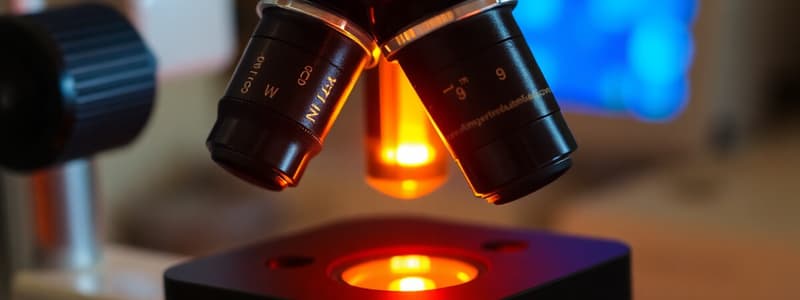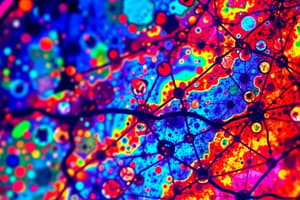Podcast
Questions and Answers
What is the primary benefit of Kohler illumination in microscopy?
What is the primary benefit of Kohler illumination in microscopy?
- Minimizes light interference by separating the light source from the objective lens. (correct)
- Reduces the need for proper optical alignment.
- Enhances color temperature adjustments during imaging.
- Increases the magnification level of the specimen.
Which component directly focuses light onto the specimen in a microscope?
Which component directly focuses light onto the specimen in a microscope?
- The objective lens.
- The diaphragm.
- The light source.
- The condenser. (correct)
In terms of light source configurations, what is crucial for effective imaging?
In terms of light source configurations, what is crucial for effective imaging?
- Incorporation of incandescent lamps exclusively for illumination.
- Adjustable settings that are fixed for a single specimen type.
- Alignment of the light source with the optical system. (correct)
- The use of a single type of light source for all specimens.
How can adjusting the diaphragm in microscopy impact image quality?
How can adjusting the diaphragm in microscopy impact image quality?
Which technique is particularly useful for revealing details in transparent specimens?
Which technique is particularly useful for revealing details in transparent specimens?
Flashcards are hidden until you start studying
Study Notes
Principles Of Illumination
- Kohler illumination provides even illumination across the specimen.
- It separates the light source from the objective lens to minimize interference.
- Key components: light source, condenser, specimen, and objective lens.
- Achieves uniform brightness and contrast, enhancing visualization.
Microscope Optics
- Involves alignment of the light path for optimal image formation.
- The condenser focuses light onto the specimen, ensuring proper illumination angle.
- Properly set diaphragm controls the amount of light and contrast.
- The objective lens captures the light from the illuminated specimen, magnifying the image.
Light Source Configurations
- Common light sources include incandescent lamps and LED lights.
- Kohler illumination requires a focused light source, often using a collector lens.
- Compatibility between the light source and the optical system is crucial.
- Adjustments can be made for intensity and color temperature to improve imaging based on specimen type.
Image Clarity Enhancement
- Adjusting the diaphragm and condenser improves depth of field and contrast.
- Fine-tuning focus between the light source and the objective lens enhances image sharpness.
- Use of phase contrast techniques can reveal details in transparent specimens.
- Proper alignment of optics reduces aberrations, leading to clearer images.
Principles Of Illumination
- Kohler illumination is essential for achieving uniform illumination across the specimen, ensuring consistent visibility.
- Separation of the light source from the objective lens minimizes interference, improving image quality.
- Key components involved include the light source, condenser, specimen, and objective lens.
- This technique enhances visualization through increased uniform brightness and contrast, crucial for accurate observation.
Microscope Optics
- Aligning the light path is vital for optimal image formation in microscopy.
- The condenser's role is to focus light onto the specimen, maintaining the correct illumination angle for clarity.
- The diaphragm regulates light intensity, allowing for adjustments in contrast to suit various specimens.
- The objective lens magnifies the light captured from the illuminated specimen, fundamentally increasing detail in the image.
Light Source Configurations
- Common light sources used in microscopy include incandescent lamps and LED lights, each with distinct characteristics.
- Kohler illumination requires a focused light source, typically utilizing a collector lens for enhanced performance.
- Ensuring compatibility between the light source and the optical system is critical for effective imaging.
- Adjustments to light intensity and color temperature enhance imaging quality based on specific specimen requirements.
Image Clarity Enhancement
- Adjustments to the diaphragm and condenser contribute to improvements in depth of field and contrast in microscopy.
- Fine-tuning focus between the light source and the objective lens is key to enhancing image sharpness, providing clearer visuals.
- Phase contrast techniques can be employed to uncover details in transparent specimens, which are often challenging to observe.
- Proper alignment of optical components is essential for reducing aberrations, resulting in clearer and more precise images.
Studying That Suits You
Use AI to generate personalized quizzes and flashcards to suit your learning preferences.




